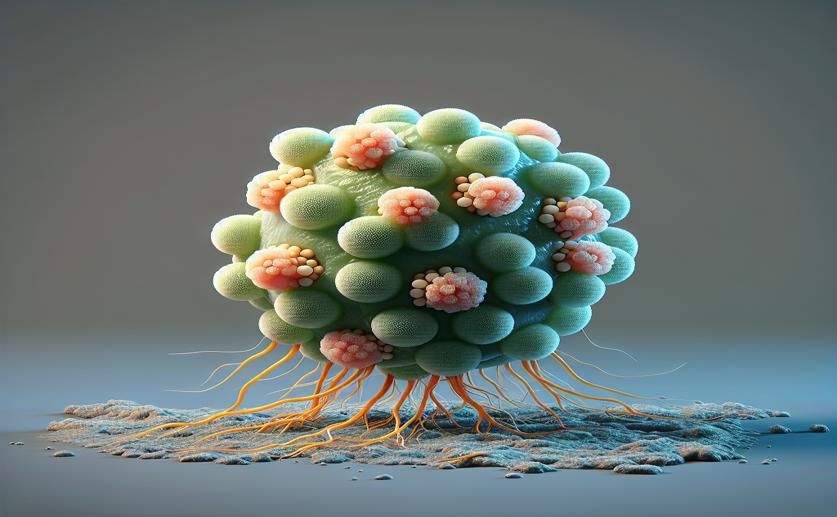Mutant Microbe Improves Its Plant Nodulation Despite Fat Production Changes

Image Source: Natural Science News, 2024
Get ready for a tiny journey through the microscopic world of bacteria and plants, where a small change can have quite the ripple effect. Picture this: beneficial bacteria called rhizobia snugly tucked in the root nodules of legume plants like clover, peas, and alfalfa. Here, they perform a vital task – converting nitrogen from the air into a form the plant can actually munch on. It's a classic case of mutual back-scratching where both partners benefit. But what happens when these bacterial buddies can't make a key ingredient in their cellular recipe?
Scientists studying this microbial handshake have scratched their heads over a particular molecule named phosphatidylcholine, or PC for short. This molecule is believed to be a VIP guest at the root-nodule party. But throw a PC-deficient mutant strain of Sinorhizobium meliloti, a type of rhizobia, into the mix, and we get a party pooper. This cranky bacterium stirs up too much of a gooey substance called succinoglycan, forgets how to swim, and worst of all, can't cozy up into the plant roots to form nodules – effectively ghosting its plant host, alfalfa.
That's where scientists come in, playing matchmakers by nabbing some of these lonely bacteria and coaxing them back into swimming and not overproducing that goopy succinoglycan. How, you ask? By teasing out natural mutations in these bacteria which, like flipping a switch, can override the problematic traits even without PC. Previously, they figured that tinkering with a protein named ExoS could lead to such a reversal. And now, hot off the presses from the scientific community, comes an interesting twist.
Turns out, not just ExoS but a range of other proteins – namely ChvI, FabA, and RpoH1 – have joined the 'fix-it' club. These tiny molecular tweaks manage to get the bacteria back into their swim-shorts and, strikingly, restore their root-nodule forming capabilities on our leafy friend, the alfalfa plant. But (and there's always a but), while these bacteria regain their party invites, they don't quite bring their A-game. They sneak into the plant roots, form nodules, but these nodules... well, they're a bit underwhelmed.
These nodules turn out to be the wallflowers of the bacterial world. They stay pale without the blush that comes from leghemoglobin, a molecule that typically gives healthy nodules a pinkish hue – a telltale sign they are bustling with nitrogen-fixing action. Here, though, there's no nitrogen love being shared. It's like sneaking into a party but then hiding in the corner, not dancing.
But hold on, the plot thickens. In the array of these undercover operative bacteria, the scientists zoomed in on one that stood out. This particular bacteria pulled a switcheroo on its fatty acid wardrobe, thanks to a mutation in the FabA protein. Instead of the usual unsaturated long-chain fatty acids, this bacterium strutted out with increased amounts of shorter chain fatty acids – kind of like swapping a trench coat for a snazzy jacket. Oddly enough, this change in fashion partially compensated for the missing PC, helping the cell to maintain membrane homeostasis. Imagine that – turning a bug into a feature!
What does this mean? Well, it seems that by tinkering with their molecular innards, these bacteria can still hobnob with the plants, albeit not perfectly. This research not only tells us about the adaptability of these microscopic critters but the delicate balance of cellular machinery and how even the tiniest alteration can have big implications for bacterial lifestyles and, in turn, agricultural prosperity. By figuring out the molecular nitty-gritty of this symbiosis, researchers can potentially find new ways to help these little guys help our crops, especially in our efforts toward a more sustainable agriculture.
Despite the hiccup with nitrogen-fixation, this experimentation in bacterial fashion choices sheds light on the resilience and adaptability of life's processes, and offers exciting possibilities for bioengineering and agriculture. So, here's to the microbe stylists, working in the shadows, learning the delicate art of bringing finicky bacteria back into the fold, and maybe, just maybe, helping them to get their groove back on the microscopic dance floor of life.
BiotechGeneticsPlant Science
References
Main Study
1) Phosphatidylcholine-deficient suppressor mutant of Sinorhizobium meliloti, altered in fatty acid synthesis, partially recovers nodulation ability in symbiosis with alfalfa (Medicago sativa).
Published 11th February, 2024
https://doi.org/10.1111/tpj.16661
Related Articles





 25th January, 2024 | Greg Howard
25th January, 2024 | Greg Howard